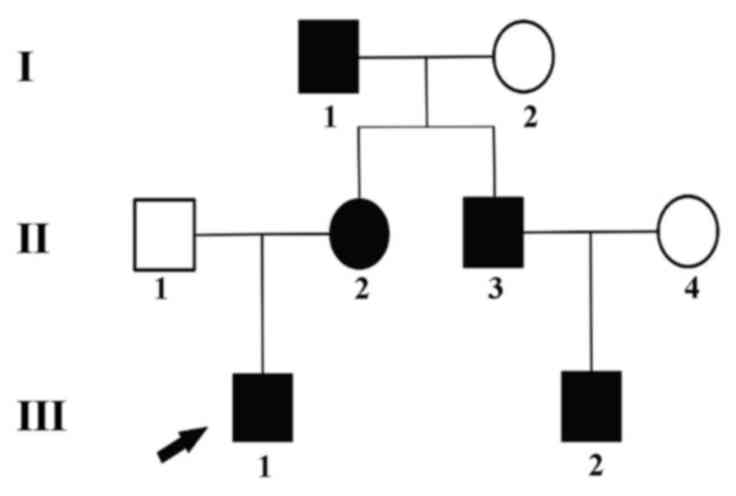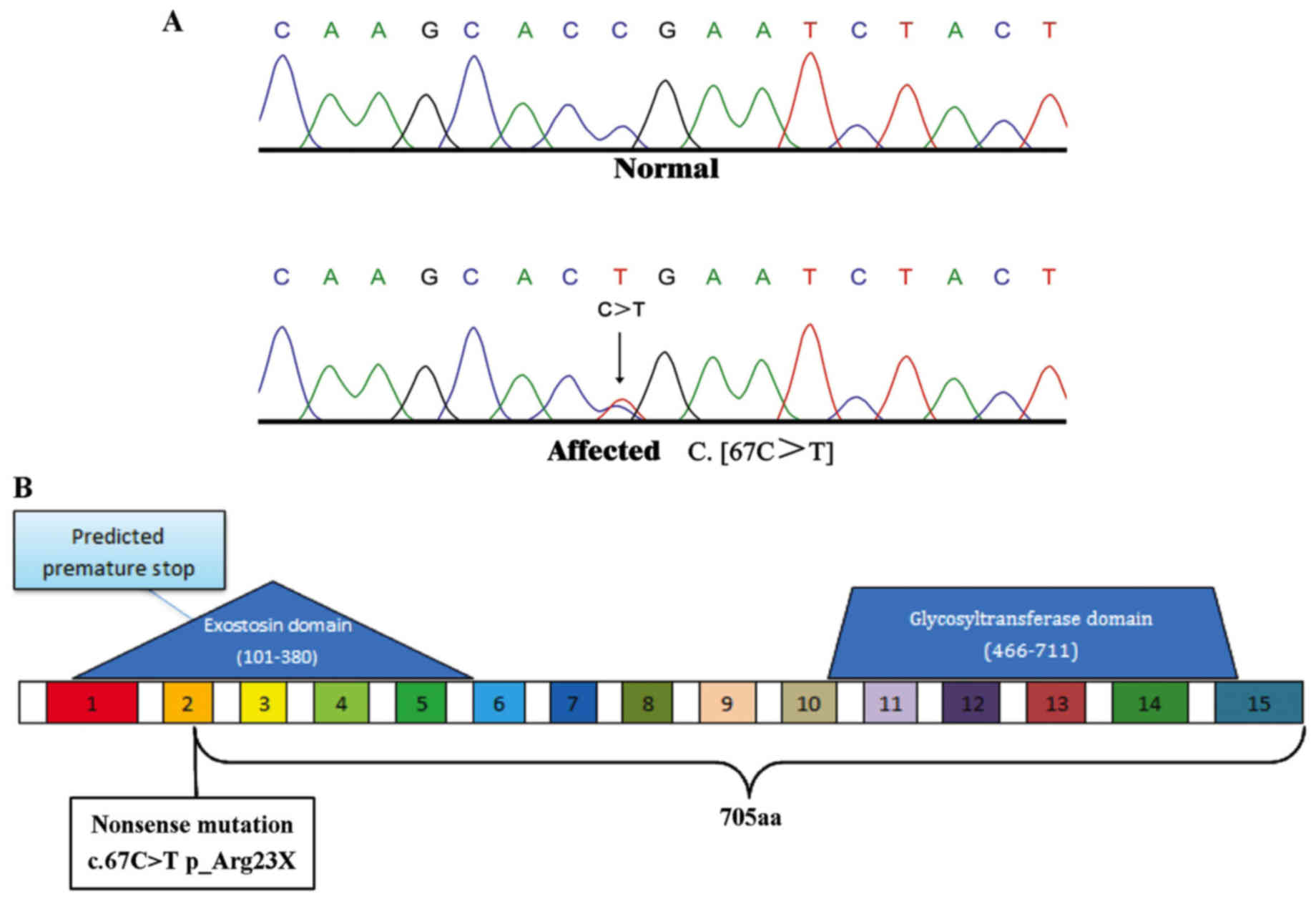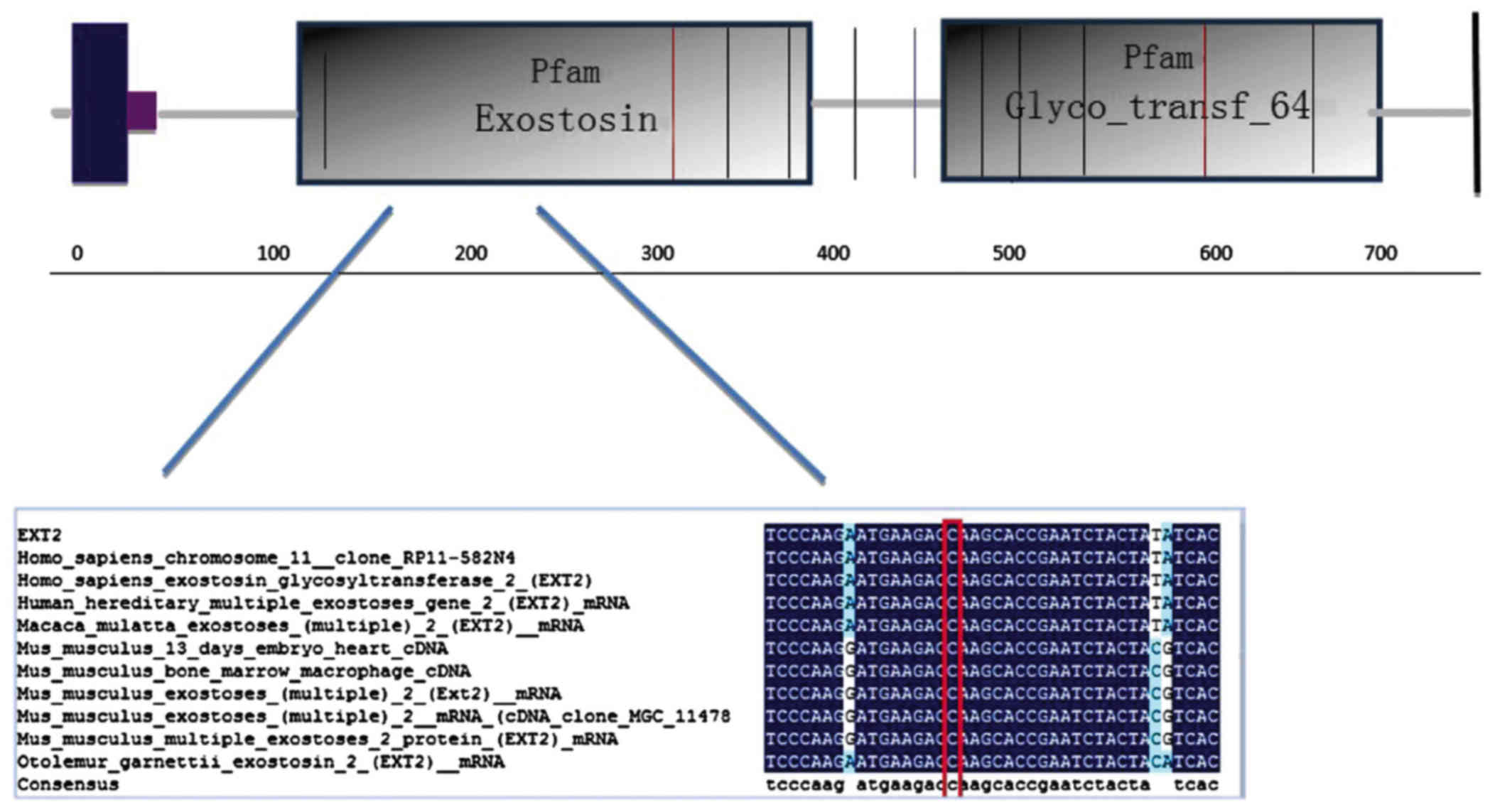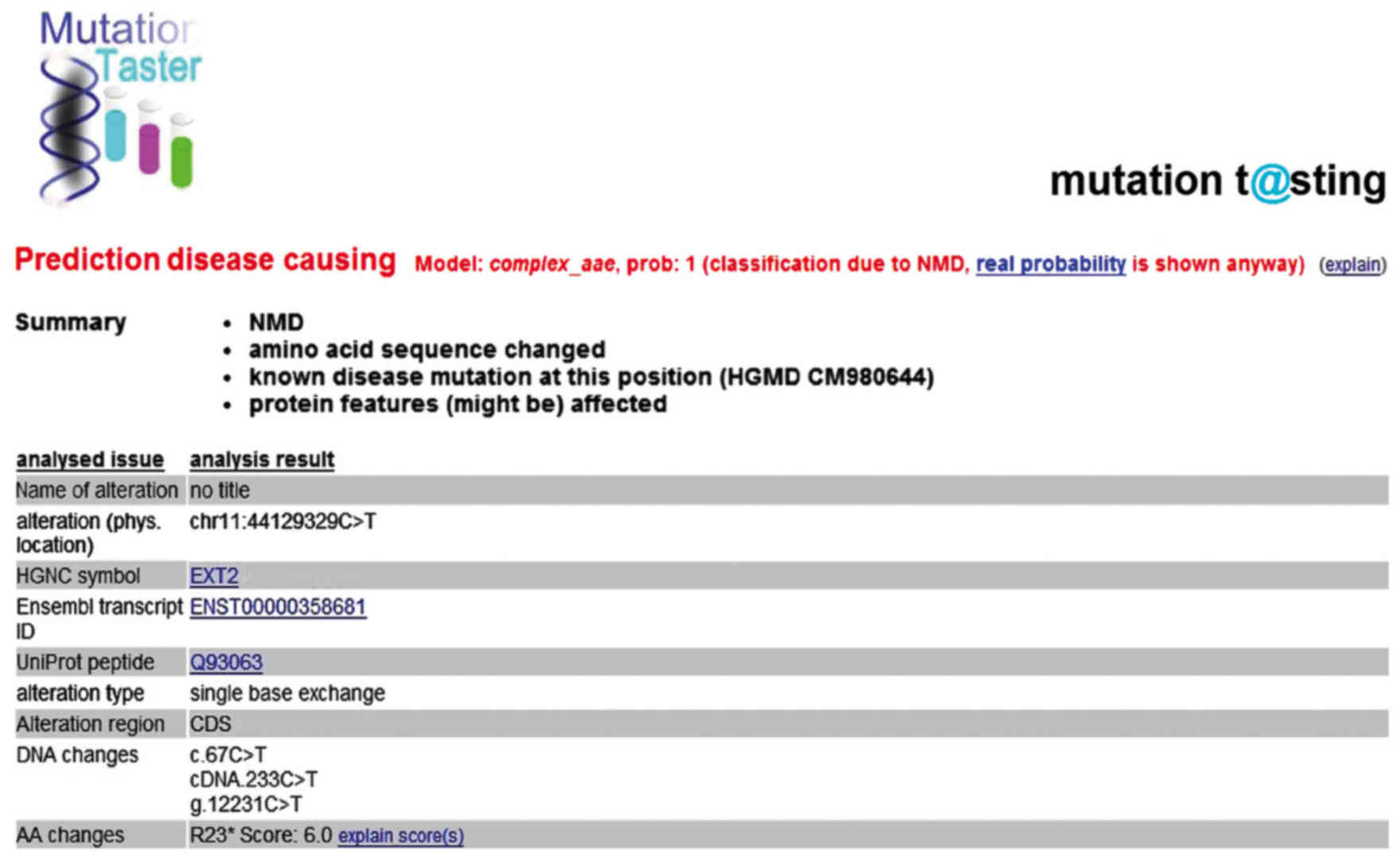|
1
|
Black B, Dooley J, Pyper A and Reed M:
Multiple hereditary exosloses. An epidemiologie study of an
isolated community in Manitoba. Clin Oahop Ralat Res. 1–217.
1993.
|
|
2
|
Peterson HA: Multiple hereditary
osteochondromata. Clin Orthop Relat Res. 1–230. 1989.
|
|
3
|
Hennekam RC: Hereditary multiple
exostoses. J Med Genet. 28:262–266. 1991. View Article : Google Scholar : PubMed/NCBI
|
|
4
|
Schmale GA, Conrad EU III and Raskind WH:
The natural history of hereditary multiple exostoses. J Bone Joint
Surg Am. 76:986–992. 1994. View Article : Google Scholar : PubMed/NCBI
|
|
5
|
Legeai-Mallet L, Munnich A, Maroteaux P
and Le Merrer M: Incomplete penetrance and expressivity skewing in
hereditary multiple exostoses. Clin Genet. 52:12–16. 1997.
View Article : Google Scholar : PubMed/NCBI
|
|
6
|
Wicklund CL, Pauli RM, Johnston D and
Hecht JT: Natural history study of hereditary multiple exostoses.
Am J Med Genet. 55:43–46. 1995. View Article : Google Scholar : PubMed/NCBI
|
|
7
|
Gordon SL, Buchanan JR and Ladda RL:
Hereditarymultiple exostoses: Report of a kindred. J Med Genet.
18:428–430. 1981. View Article : Google Scholar : PubMed/NCBI
|
|
8
|
Shupe JL, Leone NC, Olson AE and Gardner
EJ: Hereditary multiple exostoses: Clinicopathologic features of a
comparative study in horses and man. Am J Vet Res. 40:751–757.
1979.PubMed/NCBI
|
|
9
|
Paik NJ, Han TR and Lim SJ: Multiple
peripheral nerve compressions related to malignantly transformed
hereditary multiple exostoses. Muscle Nerve. 23:1290–1294. 2000.
View Article : Google Scholar : PubMed/NCBI
|
|
10
|
Khurana J, Abdul-Karim F and Bovée JVMG:
OsteochondromaPathology and Genetics of Tumours of Soft Tissue and
Bone. Fletehe CDM, Unni KK and Mertens F: World Health Organization
Classification of Tumours; Lyon, France: pp. 228–230. 2002
|
|
11
|
Saglik Y, Altay M, Unal VS, Basarir K and
Yildiz Y: Manifestations and management of osteochondromas: A
retrospective analysis of 382 patients. Acta Orthop Belg.
72:748–755. 2006.PubMed/NCBI
|
|
12
|
Porter DE, Lonie L, Fraser M, Dobson-Stone
C, Porter JR, Monaco AP and Simpson AH: Severity of disease and
risk of malignant change in hereditary multiple exostoses. A
genotype-phenotype study. J Bone Joint Surg Br. 86:1041–1046. 2004.
View Article : Google Scholar : PubMed/NCBI
|
|
13
|
Stieber JR and Dormans JP: Manifestations
of herecitary multiple exestoses. J Am Acac Orthop Surg.
13:110–120. 2005. View Article : Google Scholar
|
|
14
|
Francannet C, Cohen-Tanugi A, Le Merrer M,
Munnich A, Bonaventure J and Legeai-Mallet L: Genotype-phenotype
correlation in hereditary multiple exostoses. J Med Genet.
38:430–434. 2001. View Article : Google Scholar : PubMed/NCBI
|
|
15
|
Faiyaz-UI-Hague M, Ahmac W, Zaici SH,
Hussain S, Haque S, Ahmad M, Cohn DH and Tsui LC: Novel mutations
in the EXT1 gene in two consanguineous families affectec with
multiple herecitary exostoses (familial osteochoncromatosis). Clin
Genet. 66:144–151. 2004. View Article : Google Scholar : PubMed/NCBI
|
|
16
|
Kang Z, Peng F and Ling T: Mutation
screening of EXT genes in Chinese patients with multiple
osteochondromas. Gene. 506:298–300. 2012. View Article : Google Scholar : PubMed/NCBI
|
|
17
|
China National Physique Monitoring center,
. Workbook of public physique monitoring program. 2014.(In
Chinese).
|
|
18
|
Schwarz JM, Rödelsperger C, Schuelke M and
Seelow D: MutationTaster evaluates disease-causing potential of
sequence alterations. Nat Methods. 7:575–576. 2010. View Article : Google Scholar : PubMed/NCBI
|
|
19
|
Cao L, Liu F, Kong M, Fang Y, Gu H, Chen
Y, Zhao C, Zhang S and Bi Q: Novel EXT1 mutation identified in a
pedigree with hereditary multiple exostoses. Oncol Rep. 31:713–718.
2014. View Article : Google Scholar : PubMed/NCBI
|
|
20
|
Bovée JV: Multiple osteochondromas.
Orphanet J Rare Dis. 3:32008. View Article : Google Scholar : PubMed/NCBI
|
|
21
|
Jennes I, Zuntini M, Mees K, Palagani A,
Pedrini E, De Cock G, Fransen E, Vanden Berghe W, Sangiorgi L and
Wuyts W: Identification and functional characterization of the
human EXT1 promoter region. Gene. 492:148–159. 2012. View Article : Google Scholar : PubMed/NCBI
|
|
22
|
Wuyts W, Van Hul W, De Boulle K, Hendrickx
J, Bakker E, Vanhoenacker F, Mollica F, Lüdecke HJ, Sayli BS,
Pazzaglia UE, et al: Mutations in the EXT1 and EXT2 genes in
hereditary multiple exostoses. Am J Hum Genet. 62:346–354. 1998.
View Article : Google Scholar : PubMed/NCBI
|
|
23
|
Shimokawa K, Kimura-Yoshida C, Nagai N,
Mukai K, Matsubara K, Watanabe H, Matsuda Y, Mochida K and Matsuo
I: Cell surface heparan sulfate chains regulate local reception of
FGF signaling in the mouse embryo. Dev Cell. 21:257–272. 2011.
View Article : Google Scholar : PubMed/NCBI
|
|
24
|
Yanagishita M and Hascall VC: Cell surface
heparan sulfate proteoglycans. J Biol Chem. 267:9451–9454.
1992.PubMed/NCBI
|
|
25
|
Hecht JT, Hayes E, Haynes R, Cole WG, Long
RJ, Farach-Carson MC and Carson DD: Differentiation-induced loss of
heparan sulfate in human exostosis derived chondrocytes.
Differentiation. 73:212–221. 2005. View Article : Google Scholar : PubMed/NCBI
|
|
26
|
Lindahl U: Heparan sulfate-protein
interactions-a concept for drug design. Thromb Haemost. 98:109–115.
2007.PubMed/NCBI
|
|
27
|
Kim BT, Kitagawa H, Tamura J, Saito T,
Kusche-Gullberg M, Lindahl U and Sugahara K: Human tumor suppressor
EXT gene family members EXTL1 and EXTL3 encode alpha
1,4-N-acetylglucosaminyltransferases that likely are involved in
heparan sulfate/heparin biosynthesis. Proc Natl Acad Sci USA.
98:pp. 7176–7181. 2001; View Article : Google Scholar : PubMed/NCBI
|
|
28
|
Busse M, Feta A, Presto J, Wilén M,
Grønning M, Kjellén L and Kusche-Gullberg M: Contribution of EXT1,
EXT2, and EXTL3 to heparan sulfate chain elongation. J Biol Chem.
282:32802–32810. 2007. View Article : Google Scholar : PubMed/NCBI
|
|
29
|
Mccormick C, Duncan G, Goutsos KT and
Tufaro F: The putative tumor suppressors EXT1 and EXT2 form a
stable complex that accumulates in the Golgi apparatus and
catalyzes the synthesis of heparan sulfate. Proc Natl Acad Sci USA.
97:pp. 668–673. 2000; View Article : Google Scholar : PubMed/NCBI
|
|
30
|
Esko JD and Selleck SB: Order out of
chaos: Assembly of ligand binding sites in heparan sulfate. Annu
Rev Biochem. 71:435–471. 2002. View Article : Google Scholar : PubMed/NCBI
|
|
31
|
Nadanaka S and Kitagawa H: Heparan
sulphate biosynthesis and disease. J Biochem. 144:7–14. 2008.
View Article : Google Scholar : PubMed/NCBI
|
|
32
|
The I, Bellaiche Y and Perrimon N:
Hedgehog movement is regulated through tout velu-dependent
synthesis of a heparan sulfate proteoglycan. Mol Cell. 4:633–639.
1999. View Article : Google Scholar : PubMed/NCBI
|
|
33
|
Maeda Y, Nakamura E, Nguyen MT, Suva LJ,
Swain FL, Razzaque MS, Mackem S and Lanske B: Indian Hedgehog
produced by postnatal chondrocytes is essential for maintaining a
growth plate and trabecular bone. Proc Natl Acad Sci USA. 104:pp.
6382–6387. 2007; View Article : Google Scholar : PubMed/NCBI
|
|
34
|
Wang W, Lian N, Li L, Moss HE, Wang W,
Perrien DS, Elefteriou F and Yang X: Atf4 regulates chondrocyte
proliferation and differentiation during endochondral ossification
by activating Ihh transcription. Development. 136:4143–4153. 2009.
View Article : Google Scholar : PubMed/NCBI
|
|
35
|
Lin AC, Seeto BL, Bartoszko JM, Khoury MA,
Whetstone H, Ho L, Hsu C, Ali SA and Alman BA: Modulating hedgehog
signaling can attenuate the severity of osteoarthritis. Nat Med.
15:1421–1425. 2009. View Article : Google Scholar : PubMed/NCBI
|
|
36
|
Pathi S, Rutenberg JB, Johnson RL and
Vortkamp A: Interaction of Ihh and BMP/Noggin signaling during
cartilage differentiation. Dev Biol. 209:239–253. 1999. View Article : Google Scholar : PubMed/NCBI
|
|
37
|
Bitgood MJ and Mcmahon AP: Hedgehog and
Bmp genes are coexpressed at many diverse sites of cell-cell
interaction in the mouse embryo. Dev Biol. 172:126–138. 1995.
View Article : Google Scholar : PubMed/NCBI
|
|
38
|
Kobayashi T, Lyons KM, McMahon AP and
Kronenberg HM: BMP signaling stimulates cellular differentiation at
multiple steps during cartilage development. Proc Natl Acad Sci
USA. 102:pp. 18023–18027. 2005; View Article : Google Scholar : PubMed/NCBI
|
|
39
|
Kronenberg HM: Developmental regulation of
the growth plate. Nature. 423:332–336. 2003. View Article : Google Scholar : PubMed/NCBI
|
|
40
|
Minina E, Kreschel C, Naski MC, Ornitz DM
and Vortkamp A: Interaction of FGF, Ihh/Pthlh, and BMP signaling
integrates chondrocyte proliferation and hypertrophic
differentiation. Dev Cell. 3:439–449. 2002. View Article : Google Scholar : PubMed/NCBI
|
|
41
|
Stickens D, Clines G, Burbee D, Ramos P,
Thomas S, Hogue D, Hecht JT, Lovett M and Evans GA: The EXT2
multiple exostoses gene defines a family of putative tumour
suppressor genes. Nat Genet. 14:25–32. 1996. View Article : Google Scholar : PubMed/NCBI
|
|
42
|
Bornemann DJ, Park S, Phin S and Warrior
R: A translational block to HSPG synthesis permits BMP signaling in
the early Drosophila embryo. Development. 135:1039–1047. 2008.
View Article : Google Scholar : PubMed/NCBI
|
|
43
|
Bornemann DJ, Duncan JE, Staatz W, Selleck
S and Warrior R: Abrogation of heparan sulfate synthesis in
Drosophila disrupts the Wingless, Hedgehog and Decapentaplegic
signaling pathways. Development. 131:1927–1938. 2004. View Article : Google Scholar : PubMed/NCBI
|
|
44
|
Bishop JR, Schuksz M and Esko JD: Heparan
sulphate proteoglycans fine-tune mammalian physiology. Nature.
446:1030–1037. 2007. View Article : Google Scholar : PubMed/NCBI
|
|
45
|
Alvarez C, Tredwell S, De Vera M and
Hayden M: The genotype-phenotype correlation of hereditary multiple
exostoses. Clin Genet. 70:122–130. 2006. View Article : Google Scholar : PubMed/NCBI
|



















